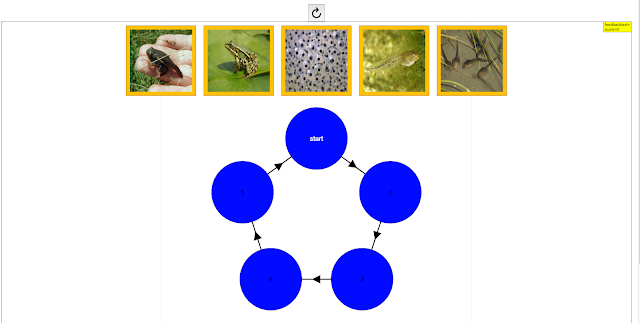Translations
| Code | Language | Translator | Run | |
|---|---|---|---|---|
 |
||||
Credits


 lookang; Felix J. Garcia Clemente; Francisco Esquembre
lookang; Felix J. Garcia Clemente; Francisco Esquembre
- Physics @ Singapore"
Overview:
This briefing document reviews two interconnected resources focused on the life cycles of various animals. The first source appears to be the core resource, likely containing information and potentially interactive elements about the life cycles of frogs, humans, chickens, grasshoppers, cockroaches, mosquitoes, beetles, and butterflies. The second source is a drag-and-drop quiz in HTML5 format, utilizing the same animal examples, and is hosted on the Open Educational Resources / Open Source Physics @ Singapore platform. These resources are designed for primary level science education, specifically targeting the concept of "Cycles" in nature, with a focus on the life cycles of living things.
Main Themes and Important Ideas/Facts:
- Concept of Life Cycles: The central theme is the understanding of life cycles as "repeated patterns of change in nature." This concept is explicitly stated in the "Sample Learning Goals" section: "There are repeated patterns of change around us." The resources aim to illustrate this through various animal examples.
- Importance of Observing Cycles: The materials emphasize the practical benefits of understanding cycles, stating that "Observing cycles helps us to make predictions and understand things around us." This aligns with the broader goal of appreciating the Earth as a self-sustaining system.
- Comparative Study of Life Cycles: A key learning objective is to "Observe and compare the life cycles of animals over a period of time (butterfly, beetle, mosquito, grasshopper, cockroach, chicken, frog)." This suggests that the resources will highlight similarities and differences in the developmental stages of these diverse animals.
- Different Types of Life Cycles: The resources implicitly introduce the concept of different types of insect development. By including examples like grasshoppers and cockroaches (which undergo incomplete metamorphosis with a nymph stage) alongside beetles and butterflies (which undergo complete metamorphosis with larval and pupal stages), the resources provide a basis for comparison. The inclusion of frogs, humans, and chickens further broadens this comparison to vertebrate life cycles.
- Interactive Learning: The presence of an HTML5 drag-and-drop quiz ("Life cycle of Frog, Human, Chicken, Grasshopper, Cockroach, Mosquito, Bettle and Butterfly Drag and Drop Quiz HTML5") highlights the use of interactive methods for learning and assessment. The embed code provided allows for easy integration of the quiz into web pages, promoting accessibility.
- Alignment with Educational Standards: The resources are linked to the Singaporean Primary 4 Science syllabus, specifically addressing the topic of "Cycles in plants and animals (Lifecycles)." The reference to the "science-primary-2014.pdf" suggests alignment with specific curriculum aims.
- Inquiry-Based Learning: The "Sample Learning Goals" include key inquiry questions like "What makes a cycle?" and "Why are cycles important to life?" This suggests an intention to encourage students to think critically and ask questions about the topic.
- Promoting Scientific Attitudes: Beyond knowledge acquisition, the resources aim to foster scientific attitudes such as "curiosity in exploring the surrounding plants and animals" and "concern by being responsible towards plants and animals."
Specific Animal Life Cycle Stages (Implied):
The direct links provided "For Teachers" detail the specific life cycle stages likely covered for each animal:
- Frog: Egg, Young, Adult
- Human: Egg, Young, Adult
- Chicken: Egg, Young, Adult
- Grasshopper: Egg, Nymph, Adult
- Cockroach: Egg, Nymph, Adult
- Mosquito: Egg, Nymph, Adult
- Beetle: Egg, Larva, Pupa, Adult
- Butterfly: Egg, Larva, Pupa, Adult
This list confirms the inclusion of both incomplete (nymph stage) and complete (larva and pupa stages) metamorphosis within the insect examples. The "Egg, Young, Adult" categorization for frog, human, and chicken represents a more general overview of their developmental stages.
Quotes from Original Sources:
- From "Life cycle of Frog, Human, Chicken, Grasshopper, Cockroach, Mosquito, Beetle and Butterfly Drag and Drop Quiz HTML5":
- "There are repeated patterns of change around us." (Under "Essential Takeaways" for "Cycles")
- "Observing cycles helps us to make predictions and understand things around us." (Under "Essential Takeaways" for "Cycles")
- "Observe and compare the life cycles of animals over a period of time (butterfly, beetle, mosquito, grasshopper, cockroach, chicken, frog)." (Under "Primary 4 Science" learning objectives)
- The title of the first source, "Life cycle of Frog, Human, Chicken, Grasshopper, Cockroach, Mosquito, Beetle and Butterfly," directly indicates the scope of the content.
Additional Information:
- The resources are attributed to lookang, Felix J. Garcia Clemente, and Francisco Esquembre.
- They are part of the Open Educational Resources / Open Source Physics @ Singapore project.
- The HTML5 quiz utilizes the EasyJavaScriptSimulations (EJS) framework.
- A YouTube video link is provided, suggesting a potential visual component to the learning materials.
- The inclusion of numerous other resources listed under the accordion FAQ indicates a broader collection of interactive simulations and tools available on the platform, but these are not directly related to the animal life cycle content.
Conclusion:
These educational resources provide a valuable tool for teaching primary school students about the concept of life cycles through a comparative study of diverse animal examples. The interactive drag-and-drop quiz enhances engagement and allows for self-assessment. The alignment with the Singaporean science curriculum and the emphasis on inquiry-based learning make these resources relevant and potentially effective for educators. The inclusion of animals with different types of development (incomplete and complete metamorphosis) offers opportunities for deeper learning and comparison.
Life Cycle Study Guide
Key Concepts:
- Life Cycle: The series of changes in form that an organism undergoes, returning to the starting state.
- Stages of Development: The distinct phases within a life cycle, often characterized by different physical forms and behaviors.
- Metamorphosis: A biological process by which an animal physically develops after birth or hatching, involving a conspicuous and relatively abrupt change in the animal's body structure through cell growth and differentiation. This can be complete (egg, larva, pupa, adult) or incomplete (egg, nymph, adult).
- Comparison: Identifying similarities and differences between the life cycles of different organisms.
- Patterns of Change: Recognizing the cyclical nature of life and the predictable sequences within life cycles.
- Adaptation: How different life cycle stages suit the environment and needs of the organism at that time.
- Prediction: Using knowledge of life cycles to anticipate future stages or events.
- Self-sustaining System: Understanding how life cycles contribute to the continuation of species and the balance of ecosystems.
Quiz:
- Describe the general concept of a life cycle. What fundamental characteristic defines it as a cycle?
- What are the three main stages generally observed in the life cycles of a frog, human, and chicken, as indicated by the provided resources?
- Explain the difference between incomplete and complete metamorphosis, referencing specific examples from the list of organisms provided.
- Identify two essential takeaways about cycles in nature, as highlighted in the "Sample Learning Goals" section of the quiz resource. Why is understanding these cycles important?
- List the three life cycle stages of a grasshopper and a cockroach, noting any similarities in their developmental pattern.
- What are the four stages of complete metamorphosis observed in insects like beetles and butterflies? Briefly describe one characteristic of the larval stage.
- According to the "Primary 4 Science" section, what should students be able to do regarding animal life cycles? What attitude should they show towards living things?
- How does the life cycle of a mosquito differ from that of a grasshopper, based on the stages mentioned in the resources?
- Explain why observing and understanding life cycles can help us make predictions about the natural world. Provide a specific example related to one of the listed organisms.
- How do the provided resources suggest teachers can make learning about life cycles more meaningful and enjoyable for students?
Answer Key:
- A life cycle is the complete sequence of developmental stages that an organism goes through from its initial form (e.g., egg or birth) to its mature form capable of reproduction, ultimately leading to the next generation and the cycle repeating. The fundamental characteristic is its cyclical nature, meaning it returns to the starting point, ensuring the continuation of the species.
- The three main stages observed in the life cycles of a frog, human, and chicken are egg, young, and adult. These represent the basic progression from a fertilized beginning to an immature phase of growth and finally to a sexually mature stage.
- Incomplete metamorphosis involves three stages: egg, nymph, and adult, where the nymph resembles a smaller version of the adult and gradually develops. Examples from the list include grasshoppers and cockroaches. Complete metamorphosis has four stages: egg, larva, pupa, and adult, with a significant transformation occurring in the pupal stage. Beetles and butterflies are examples.
- Two essential takeaways are that there are repeated patterns of change around us, and observing cycles helps us make predictions and understand things around us. Understanding these cycles is important because it allows us to anticipate events and processes in nature and appreciate the Earth as a self-sustaining system.
- The life cycle of a grasshopper includes the egg, nymph, and adult stages. Similarly, the life cycle of a cockroach also includes the egg, nymph, and adult stages. Both exhibit incomplete metamorphosis.
- The four stages of complete metamorphosis are egg, larva, pupa, and adult. The larval stage is typically a feeding and growing stage, often significantly different in appearance and habitat from the adult (e.g., a caterpillar for a butterfly).
- According to the "Primary 4 Science" section, students should be able to observe and compare the life cycles of animals (butterfly, beetle, mosquito, grasshopper, cockroach, chicken, frog) over a period of time. They should also show curiosity in exploring the surrounding plants and animals and question what they find, as well as show concern and responsibility towards living things.
- The life cycle of a mosquito, as indicated, includes the egg, larva, pupa, and adult stages, demonstrating complete metamorphosis. The life cycle of a grasshopper includes the egg, nymph, and adult stages, showing incomplete metamorphosis and lacking a distinct larval and pupal phase.
- Observing life cycles reveals predictable patterns of development and reproduction within species. For example, knowing the life cycle of a mosquito (egg in water, then larva, pupa, flying adult) allows us to predict when adult mosquitoes will be prevalent based on environmental conditions and to implement preventative measures at earlier stages like eliminating standing water.
- The resources suggest that freeing up curriculum time allows teachers to use more engaging teaching and learning approaches and implement customized school-based programs, as long as the aims of the syllabus are met. This enables teachers to make learning more meaningful and enjoyable for their students when teaching about topics like life cycles.
Essay Format Questions:
- Compare and contrast the life cycles of a human and a butterfly, highlighting the key differences in their stages of development and the biological significance of these differences.
- Discuss the importance of understanding life cycles in the broader context of ecological awareness and environmental responsibility. Use examples from the provided list of organisms to support your arguments.
- Analyze the concept of "cycles" as presented in the resources. How does the understanding of life cycles contribute to the appreciation of the Earth as a self-sustaining system, and what are the implications for predicting natural events?
- Evaluate the different patterns of metamorphosis observed in the life cycles of the studied organisms (complete vs. incomplete). What are the potential evolutionary advantages and disadvantages of each type of development?
- Considering the "Sample Learning Goals" and "Primary 4 Science" sections, propose effective teaching strategies that educators could use to engage primary school students in learning about the life cycles of the listed animals, making the learning process both meaningful and enjoyable.
Glossary of Key Terms:
- Adult: The final, sexually mature stage in the life cycle of an organism.
- Egg: The first stage in the life cycle of many animals, containing the developing embryo.
- Incomplete Metamorphosis: A type of metamorphosis in insects where the insect hatches from an egg into a nymph, which resembles a smaller version of the adult. The nymph goes through several molts, gradually becoming an adult.
- Larva: The immature, often worm-like feeding stage in the life cycle of insects undergoing complete metamorphosis. It is usually very different in appearance from the adult.
- Life Cycle: The series of changes in form that an organism undergoes, returning to the starting state, typically involving reproduction.
- Metamorphosis: A biological process involving a conspicuous and relatively abrupt change in an animal's body structure after birth or hatching.
- Nymph: The immature stage of an insect that undergoes incomplete metamorphosis, resembling a smaller version of the adult.
- Pupa: The transformation stage in complete metamorphosis, during which the larval tissues are broken down and the adult form develops.
- Young: A general term referring to the immature stage of an organism after hatching or birth but before reaching full adulthood.
Sample Learning Goals
Cycles There are repeated patterns of change in nature. Examples of these cycles are the life cycles of living things and the water cycle. Understanding these cycles helps Man to predict events and processes and to appreciate the Earth as a self-sustaining system. The essential takeaways and key inquiry questions for “Cycles” are: Essential Takeaways Key Inquiry Questions There are repeated patterns of change around us. Observing cycles helps us to make predictions and understand things around us. What makes a cycle? Why are cycles important to life?
Primary 4 Science
Cycles
Cycles in plants and animals (Lifecycles)
The freed up curriculum time is to enable teachers to use more engaging teaching and learning approaches, and/or to implement customised schoolbased programmes as long as the aims of the syllabus are met. This enables teachers to make learning more meaningful and enjoyable for their students.
About Cycles: There are repeated patterns of change in nature. Examples of these cycles are the life cycles of living things and the water cycle. Understanding these cycles helps Man to predict events and processes and to appreciate the Earth as a self-sustaining system.
*Observe and compare the life cycles of animals over a period of time (butterfly, beetle, mosquito, grasshopper, cockroach, chicken, frog).
*Show curiosity in exploring the surrounding plants and animals and question what they find. *Show concern by being responsible towards plants and animals such as their own pets. *Value individual effort and team work.
For Teachers
Life Cycle of Frog Drag and Drop Quiz HTML5
|
https://sg.iwant2study.org/ospsg/index.php/interactive-resources/biology/846-lifecycleanimals |
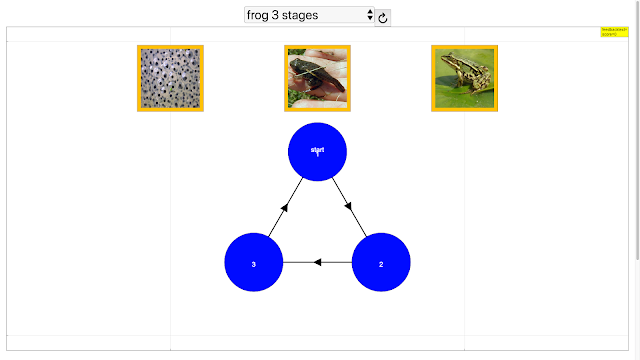 |
| The life cycle of the Frog Egg, Young and Adult https://sg.iwant2study.org/ospsg/index.php/interactive-resources/biology/846-lifecycleanimals |
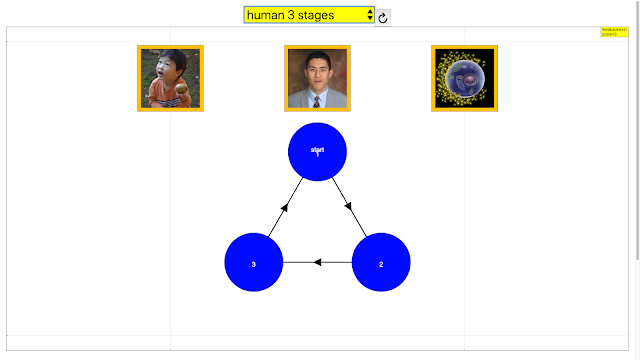 |
| The life cycle of the Human Egg, Young and Adult https://sg.iwant2study.org/ospsg/index.php/interactive-resources/biology/846-lifecycleanimals |
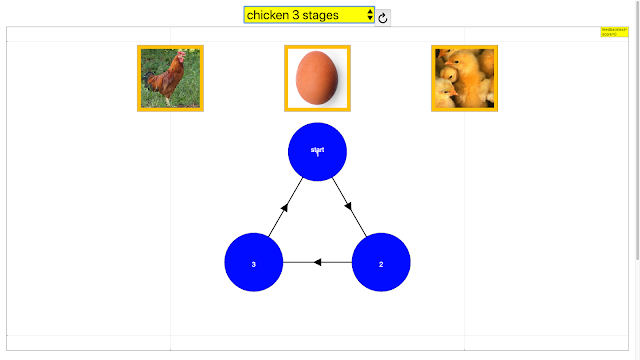 |
| The life cycle of the chicken Egg, Young and Adult https://sg.iwant2study.org/ospsg/index.php/interactive-resources/biology/846-lifecycleanimals |
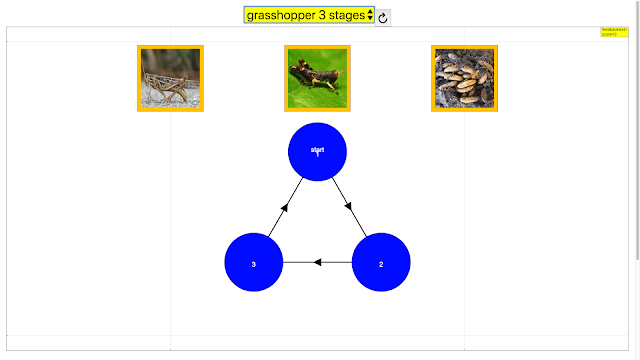 |
| The life cycle of the Grasshopper Egg, Nymph and Adult https://sg.iwant2study.org/ospsg/index.php/interactive-resources/biology/846-lifecycleanimals |
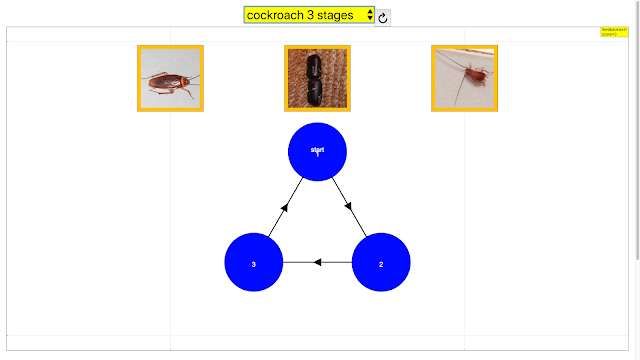 |
| The life cycle of the Cockroach Egg, Nymph and Adult https://sg.iwant2study.org/ospsg/index.php/interactive-resources/biology/846-lifecycleanimals |
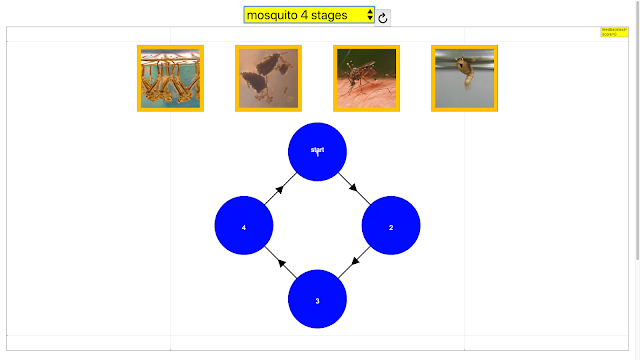 |
| The life cycle of the mosquito Egg, Nymph and Adult https://sg.iwant2study.org/ospsg/index.php/interactive-resources/biology/846-lifecycleanimals |
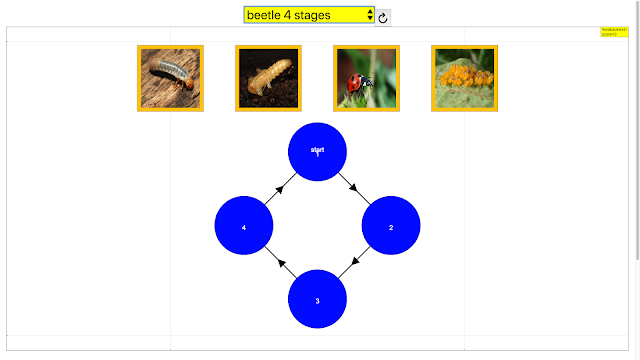 |
| The life cycle of the beetle Egg, Larva, Pupa and Adult https://sg.iwant2study.org/ospsg/index.php/interactive-resources/biology/846-lifecycleanimals |
 |
| The life cycle of the butterfly Egg, Larva, Pupa and Adult https://sg.iwant2study.org/ospsg/index.php/interactive-resources/biology/846-lifecycleanimals |
Research
[text]
Video
https://www.youtube.com/watch?v=p0RnVLP25vo
Version:
Other Resources
https://www.geogebra.org/m/f29bmujQ
Frequently Asked Questions: Animal Life Cycles
1. What is a life cycle in the context of living things? A life cycle refers to the series of stages that a living organism goes through during its lifetime, from its beginning to its reproduction. These stages often involve growth, development, and eventual reproduction, creating a repeated pattern of change in nature.
2. Why is understanding the life cycles of animals important? Understanding life cycles is crucial for several reasons. It helps us to recognize the repeated patterns of change in the natural world and allows us to make predictions about future events and processes within these cycles. Furthermore, it contributes to a broader appreciation of the Earth as a self-sustaining system where different living things interact and depend on cyclical processes.
3. What are some common stages observed in the life cycles of the featured animals (frog, human, chicken, grasshopper, cockroach, mosquito, beetle, and butterfly)? While the specific stages and their characteristics differ, many of these animals share fundamental stages such as the egg stage, a juvenile or immature stage (which may be called larva, nymph, or young), and an adult, reproductive stage.
4. How do the life cycles of insects like the grasshopper, cockroach, mosquito, beetle, and butterfly differ from those of a frog, human, and chicken? A key difference lies in the presence or absence of metamorphosis. Insects like the grasshopper, cockroach, and mosquito undergo incomplete metamorphosis, where the young (nymphs) resemble smaller versions of the adults. Beetles and butterflies undergo complete metamorphosis, which includes a larval stage that looks very different from the adult and a pupal stage where significant transformation occurs. Frogs also undergo metamorphosis from a tadpole to an adult frog. Humans and chickens, on the other hand, experience direct development where the young resemble smaller versions of the adults without a drastic change in form.
5. What does the term "Cycles" encompass beyond just animal life cycles? The concept of "Cycles" in nature extends beyond the life cycles of plants and animals. It includes other recurring patterns such as the water cycle. Recognizing these various cycles helps us understand the interconnectedness of natural phenomena and the predictable nature of many Earth systems.
6. How can studying animal life cycles be engaging for primary-level students? Observing and comparing the life cycles of different animals, especially those familiar to children like butterflies, beetles, mosquitoes, grasshoppers, cockroaches, chickens, and frogs, can spark curiosity about the natural world. Interactive tools, such as drag-and-drop quizzes, can make learning about these stages more hands-on, meaningful, and enjoyable for students.
7. What role does observation play in learning about life cycles? Direct observation of animals over time is a fundamental aspect of understanding their life cycles. By carefully observing the different stages of an animal's development, students can identify patterns of change and gain firsthand knowledge about these biological processes.
8. How can open educational resources contribute to learning about animal life cycles? Open educational resources, such as interactive simulations and quizzes available online, provide accessible and engaging tools for learning about complex topics like animal life cycles. These resources often allow for self-paced learning, visualization of different life stages, and opportunities for interactive practice, enhancing comprehension and retention
- Details
- Written by Loo Kang Wee
- Parent Category: Interactive Resources
- Category: Biology
- Hits: 14927


.png
)






